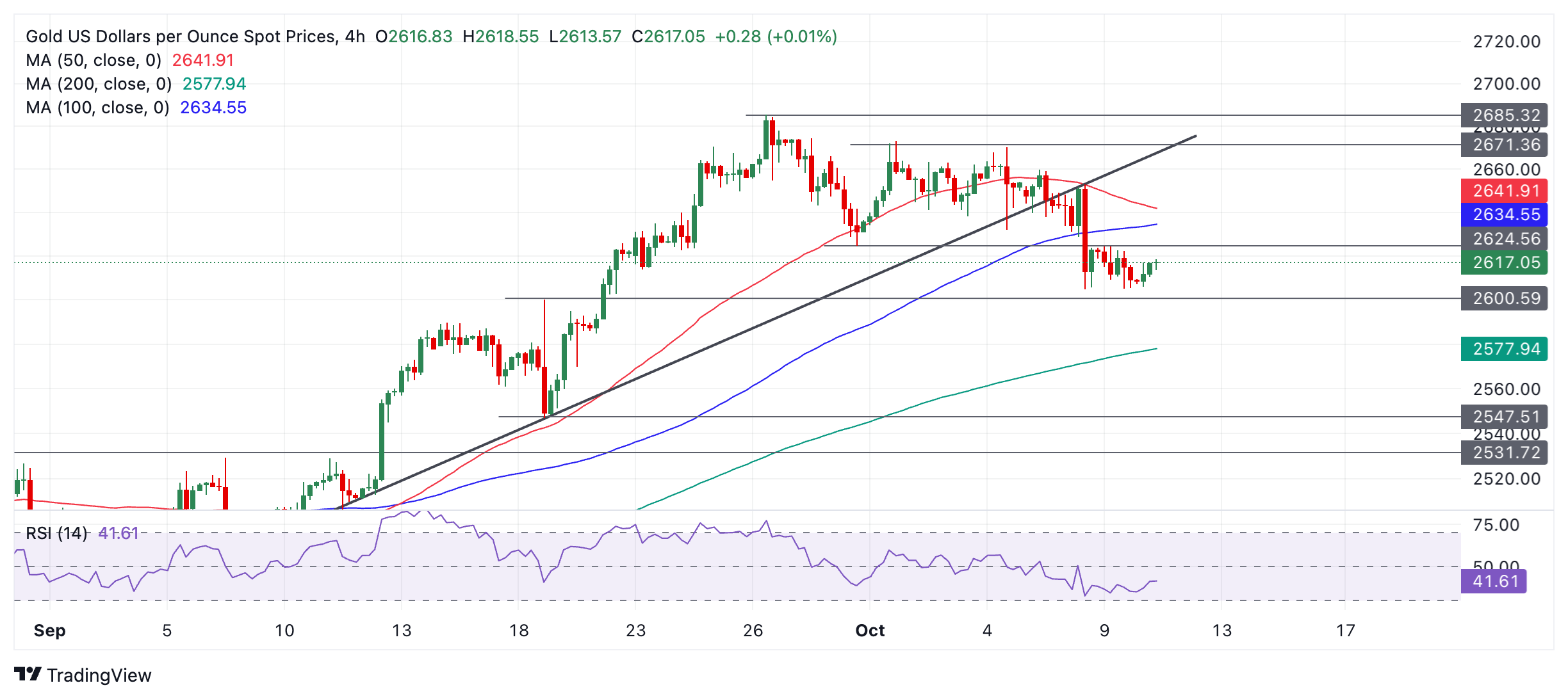Gold bounces amid dovish Fedspeak
- Gold bounces after the Reserve Bank of New Zealand implements a super-sized interest-rate cut, continuing the global trend.
- Neutral or dovish Fedspeak from a string of Fed officials further supports the precious metal.
- Technically, XAU/USD enters a short-term downtrend, biasing price action to further losses.
Gold (XAU/USD) trades back in the $2,610s on Thursday after bouncing off the psychological $2,600 level, as the yellow metal gets an uplift from the general slide in global interest rates and a string of Federal Reserve (Fed) officials strike a neutral or dovish tone at their speaking engagements.
Gold gets a lift from mega-sized RBNZ rate cut
Gold rebounded overnight after the Reserve Bank of New Zealand (RBNZ) became the latest major central bank to slash interest rates. The RBNZ implemented a super-sized 50 basis points (bps) cut to its official cash rate, bringing it down to 4.75% from 5.25% previously, at its October meeting. Lower interest rates are bullish for Gold because they reduce the opportunity cost of holding a non-interest-paying asset.
The RBNZ move helps rescue Gold from a bad start to the week in which it has lost almost 1.50% so far, mainly on the back of a brighter outlook for the US economy. This, in turn, has radically reduced bets that the Federal Reserve (Fed) will implement another double-dose 50 bps rate cut of its own at its next meeting in November.
The market-based probability of the Fed lowering by 50 bps (0.50%) has now fallen to zero, according to the CME Fedwatch tool. The chances of a smaller 25 bps cut meanwhile stand at about 85%. Further – from a cut of some magnitude being inevitable – the probability of the Fed doing nothing in November has now increased to about 15%.
Gold also gets some lift from a string of speeches by Fed policymakers on Wednesday. These were all rated as either falling in the neutral or dovish territory at the FXStreet FedTracker – meaning in favor of loose policy and low interest rates – and were all below the average for the speaker (see calendar). The FXStreet FedTracker is a new AI-powered tool that gauges the tone of Fed officials’ speeches on a dovish-to-hawkish scale from 0 to 10.
Federal Reserve Bank of San Francisco President Mary Daly (voting member) scored the lowest with a FedTracker score of 2.0, well below her 3.6 average. Daly said one or two more rate cuts were needed before the end of the year, adding, "I was more worried about the labor market," than "accelerating inflation."
The Fed’s decision-making at its November meeting may be further impacted by the release of US inflation data on Thursday, and this, in turn, could impact Gold. The Consumer Price Index (CPI) for September is expected to rise 2.3% year-over-year (YoY) from 2.5%, and core CPI to rise by 3.2% YoY, unchanged from August. If it is lower, bets may yet again increase for a rate cut; the opposite is true if inflation remains sticky.
Gold underpinned by safe-haven demand
Gold might be underpinned, however, as it continues to attract safe-haven flows amid elevated geopolitical tensions. Israel keeps up its attacks on targets in Lebanon, and markets remain on tenterhooks anticipating a retaliatory attack by Israel on Iran after its ballistic rocket raid last week.
In terms of the latest developments, the White House confirmed Israeli Prime Minister Benjamin Netanyahu spoke with US President Joe Biden on Wednesday, but nothing was mentioned about Israel’s potential retaliation against Iran. The Biden administration is pressing Israel to limit its retaliation to military targets, according to Bloomberg News and Axios News reported that Netanyahu will convene Israel’s security cabinet today.
Technical Analysis: Gold in short-term downtrend
Gold continues its short-term downtrend, reaching support at just above the psychological $2,600 mark and then bouncing.
XAU/USD 4-hour Chart

The short-term trend has switched to bearish, from previously being sideways, after Gold broke down from its narrow range and decisively breached its long-term trendline on Tuesday. Given the technical analysis principle that “the trend is your friend,” the odds favor a continuation lower in the near term.
A break below support at $2,600 (August 18 high, round number) would probably indicate further weakness toward the next downside target at $2,578, where the green 200-period Simple Moving Average (SMA) on the 4-hour chart above is likely to provide a safety net.
Bears should proceed with caution, however, as the medium and long-term trends remain bullish. If, at any moment, one of these longer up cycles resumes, Gold could stall, reverse, and begin a new up leg higher.
Economic Indicator
Consumer Price Index (YoY)
Inflationary or deflationary tendencies are measured by periodically summing the prices of a basket of representative goods and services and presenting the data as The Consumer Price Index (CPI). CPI data is compiled on a monthly basis and released by the US Department of Labor Statistics. The YoY reading compares the prices of goods in the reference month to the same month a year earlier.The CPI is a key indicator to measure inflation and changes in purchasing trends. Generally speaking, a high reading is seen as bullish for the US Dollar (USD), while a low reading is seen as bearish.
Read more.Next release: Thu Oct 10, 2024 12:30
Frequency: Monthly
Consensus: 2.3%
Previous: 2.5%
Source: US Bureau of Labor Statistics
The US Federal Reserve has a dual mandate of maintaining price stability and maximum employment. According to such mandate, inflation should be at around 2% YoY and has become the weakest pillar of the central bank’s directive ever since the world suffered a pandemic, which extends to these days. Price pressures keep rising amid supply-chain issues and bottlenecks, with the Consumer Price Index (CPI) hanging at multi-decade highs. The Fed has already taken measures to tame inflation and is expected to maintain an aggressive stance in the foreseeable future.

